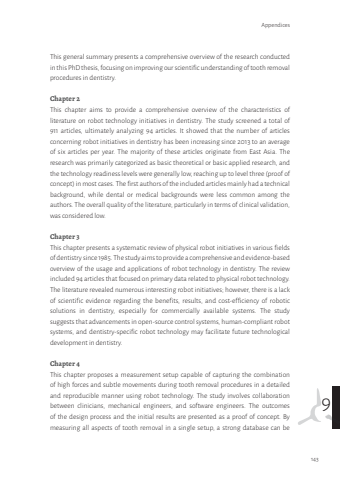Page 145 - Demo
P. 145
9Appendices143This general summary presents a comprehensive overview of the research conducted in this PhD thesis, focusing on improving our scientific understanding of tooth removal procedures in dentistry. Chapter 2This chapter aims to provide a comprehensive overview of the characteristics of literature on robot technology initiatives in dentistry. The study screened a total of 911 articles, ultimately analyzing 94 articles. It showed that the number of articles concerning robot initiatives in dentistry has been increasing since 2013 to an average of six articles per year. The majority of these articles originate from East Asia. The research was primarily categorized as basic theoretical or basic applied research, and the technology readiness levels were generally low, reaching up to level three (proof of concept) in most cases. The first authors of the included articles mainly had a technical background, while dental or medical backgrounds were less common among the authors. The overall quality of the literature, particularly in terms of clinical validation, was considered low.Chapter 3 This chapter presents a systematic review of physical robot initiatives in various fields of dentistry since 1985. The study aims to provide a comprehensive and evidence-based overview of the usage and applications of robot technology in dentistry. The review included 94 articles that focused on primary data related to physical robot technology. The literature revealed numerous interesting robot initiatives; however, there is a lack of scientific evidence regarding the benefits, results, and cost-efficiency of robotic solutions in dentistry, especially for commercially available systems. The study suggests that advancements in open-source control systems, human-compliant robot systems, and dentistry-specific robot technology may facilitate future technological development in dentistry.Chapter 4 This chapter proposes a measurement setup capable of capturing the combination of high forces and subtle movements during tooth removal procedures in a detailed and reproducible manner using robot technology. The study involves collaboration between clinicians, mechanical engineers, and software engineers. The outcomes of the design process and the initial results are presented as a proof of concept. By measuring all aspects of tooth removal in a single setup, a strong database can be Tom van Riet.indd 143 26-10-2023 11:59


